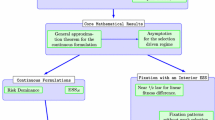Abstract
We study the accumulation of unfavourable mutations in asexual populations by the process of Muller's ratchet, and the consequent inevitable decrease in fitness of the population. Simulations show that it is mutations with only moderate unfavourable effect that lead to the most rapid decrease in fitness. We measure the number of fixations as a function of time and show that the fixation rate must be equal to the ratchet rate once a steady state is reached. Large bursts of fixations are observed to occur simultaneously. We relate this to the structure of the genealogical tree. We derive equations relating the rate of the ratchet to the moments of the distribution of the number of mutations k per individual. These equations interpolate between the deterministic limit (an infinite population with selection present) and the neutral limit (a finite size population with no selection). Both these limits are exactly soluble. In the neutral case, the distribution of k is shown to be non-self-averaging, i.e. the fluctuations remain very large even for very large populations. We also consider the strong-selection limit in which only individuals in the fittest surviving class have offspring. This limit is again exactly soluble. We investigate the structure of the genealogical tree relating individuals in the same population, and consider the probability \(\bar P\)(T) that two individuals had their latest common ancestor T generations in the past. The function \(\bar P\)(T) is exactly calculable in the neutral limit and the strong-selection limit, and we obtain an empirical solution for intermediate selection strengths.
Similar content being viewed by others
References
Bürger, R.: Moments, cumulants, and polygenic dynamics. J. Math. Biol. 30,199–213 (1991)
Charlesworth, B.: Mutation-selection balance and the evolutionary advantage of sex and recombination. Genetical Res. (Cambridge) 55, 199–221 (1990)
Charlesworth, D., Morgan, M. T., Charlesworth, B.: Mutation accumulation in finite outbreeding and inbreeding populations. Genetical Res. (Cambridge) 61, 39–56 (1993a)
Charlesworth, D., Morgan, M. T., Charlesworth, B.: Mutation accumulation in finite populations. J. Heredity 84, 321–325 (1993b)
Crow, J. F., Kimura, M.: An introduction to population genetics theory. New York: Harper and Row 1970
Derrida, B., Bessis, D.: Statistical properties of valleys in the annealed random map model. J. Phys. A (Mathematical and General) 21, 1,509–1,515 (1988)
Derrida, B., Peliti, L.: Evolution in a flat fitness landscape. Bull. Math. Biol. 53, 355–382 (1991)
Donnelly, P.: Partition structures, Polya urns, the Ewens sampling formula, and the ages of alleles. Theoret. Population Biol. 30, 271–288 (1986)
Ewens, W. J.: The sampling theory of selectively neutral alleles. Theoret. Population Biol. 3, 87–112 (1992)
Ewens, W. J.: Mathematical population genetics (Biomathematics vol. 9) Berlin: Springer 1979
Felsenstein, J.: The evolutionary advantage of reombination. Genetics 78, 737–756 (1974)
Gabriel, W., Lynch, M., Burger, R.: Muller's ratchet and mutational meltdowns. Evolution 47, 1744–1757 (1993)
Haigh, J.: The accumulation of deleterious genes in a population — Muller's ratchet. Theoret. Population Biol. 14, 251–267 (1978)
Higgs, P. G.: Error thresholds and stationary mutant distributions in multilocus diploid genetics models. Genetical Res. (Cambridge) 63, 63–78 (1994)
Higgs, P. G.: Frequency distributions in population genetics parallel those in statistical physics. Phys. Rev. E 51, 95–101 (1995)
Higgs, P. G., Derrida, B.: Stochastic models for species formation in evolving populations. J. Phys. A (Mathematical and General) 24, 1,985–1,991 (1991)
Higgs, P. G., Derrida, B.: Genetic distance and species formation in evolving populations. J. Molecular Evol. 35, 454–465 (1992)
Joyce, P., Tavaré, S.: Random premutations and neutral evolution models. Stochast. Processes and Appl. 36, 245–261 (1990)
Kauffman, S. A.: The origins of order: self-organization and selection in evolution. Oxford: Oxford University Press 1993
Kingman, J. F. C.: On the genealogy of large populations. J. Appl. Probab. 19A, 27–43 (1982)
Lynch, M., Burger, R., Butcher, D., Gabriel, W.: The mutational meltdown in asexual populations. J. Heredity 84, 339–344 (1993)
Lynch, M., Gabriel, W.: Mutation load and the survival of small populations. Evolution 44, 1725–1737 (1990)
Muller, H. J.: The relation of recombination to mutational advance. Mutation Res. 1, 2–9
Nowak, M., Schuster, P.: Error thresholds of replication in finite populations, mutation frequencies, and the onset of Muller's ratchet. J. Theoret. Biol. 137, 375–395.
Pamilo, P., Nei, M., Li, W. H.: Accumulation of mutations in sexual and asexual populations. Genetical Res. (Cambridge) 49, 135–146 (1987)
Stephan, W., Chao, L., Smale, J. G.: The advance of Muller's ratchet in a haploid asexual population: approximate solutions based on diffusion theory. Genetical Res. (Cambridge) 61, 225–231 (1993)
Tajima, F.: Evolutionary relationship of DNA sequences in finite populations. Genetics 105, 437–460 (1983)
Tavaré, S.: The birth process with immigration, and the genealogical structure of large populations. J. Math. Biol. 25, 161–168 (1987)
Wagner, G. P., Gabriel, W.: Quantitative variation in finite parthenogenic populations: what stops Muller's ratchet in the absence of recombination? Evolution 44, 715–731 (1990)
Wagner, G. P., Krall, P.: What is the difference between models of error thresholds and Muller's ratchet. J. Math. Biol. 32, 33–44 (1993)
Author information
Authors and Affiliations
Rights and permissions
About this article
Cite this article
Higgs, P.G., Woodcock, G. The accumulation of mutations in asexual populations and the structure of genealogical trees in the presence of selection. J. Math. Biol. 33, 677–702 (1995). https://doi.org/10.1007/BF00184644
Received:
Revised:
Issue Date:
DOI: https://doi.org/10.1007/BF00184644




